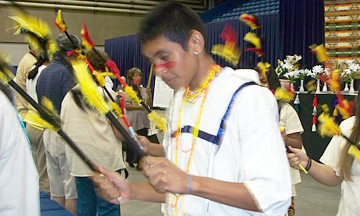
 GREENVILLE—Native Americans were this country’s first inhabitants, and as such, are the true forefathers of America.
GREENVILLE—Native Americans were this country’s first inhabitants, and as such, are the true forefathers of America.
But over the course of history, the American Indian became a somewhat invisible people, a culture that many thought had all but disappeared. Stacey Lazurek, who works with Catholic Charities and is part Cherokee, said it’s time to change that.
The biggest step, she said, is letting other Native American Indians know they are not alone and getting them to step forward with pride in their ancestry.
“When we reach out to each other we can let the rest of the world know we’re still here,” she said. Lazurek has been working with Kathleen Merritt, diocesan director of ethnic ministries, to spread the word and mobilize.
One of their first actions was to start a Kateri Circle for healing and spiritual growth at Our Lady of the Rosary Church in Greenville. Another circle is in the formation process in the Midlands through Deacon Dale Palmer.
They are also hosting the first Native American Heritage Celebration at St. Anthony of Padua Church in Greenville on Nov. 12 called “Invisible No More.”
Merritt said for a long time, two Adrian Dominican Sisters in Ridgeville ran an outreach to about 1,000 Edisto Indians in the Dorchester County community. When the sisters left, the funds were given to the office of ethnic ministries.
One obstacle is simply finding members of the various tribes still in South Carolina.
Starting with the Trail of Tears in 1838, many Native Americans have denied their heritage for fear of persecution.
Just like African Americans, they were segregated from the white population and not allowed to speak their native languages.
Mary Louise Worthy, vice chief of the Lower Eastern Cherokee, said there is still a lot of anger, resentment and fear to be overcome. She tells the story of one lady who, as a child, had her finger cut off in school because she kept speaking in her native tongue.
“It was safer to say you weren’t Indian and blend in with the rest of the population,” Worthy said.
Time has started the healing process, and Worthy, Lazurek, and other Native Americans are trying to help by speaking at schools and parishes.
At this point, they said it is more an ecumenical movement. They aren’t going in as Catholics trying to evangelize, but just to let people know who they are and what they believe.
Lazurek said people aren’t surprised as much by the Catholic aspect as they are to find out she’s American Indian. She said children and adults still hold the stereotypes of scalping and war dances — or on a more modern level, casinos.
It’s an education process.
“It’s a sad history, and it’s very tragic in a lot of ways, but we’re a resilient people,” she said. “We have stories to tell. We have a past, a history, but we also have a future to share.”
Lazurek said that can be done through tribal connections and religion. She noted that Indian spirituality is a natural fit with Catholicism, pointing out that Native beliefs about nature are very Franciscan.
Like St. Francis, Native Americans hold great respect for animals, especially birds. Lazurek said they incorporate feathers into the liturgy as a symbol of birds carrying our prayers to God.
Worthy said most American Indians were evangelized by Protestants, but a growing number are converting to Catholicism.
A 2002 study by a USCCB committee on Native American Catholics noted the widespread presence of American Indians in dioceses and pointed out that this culture tends to be “invisible to the local church.”
Lazurek said their goal is to stand up and be visible.
For more information on the cultural celebration, call (864) 242-2233.
